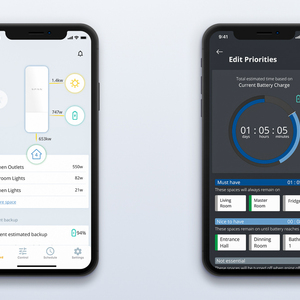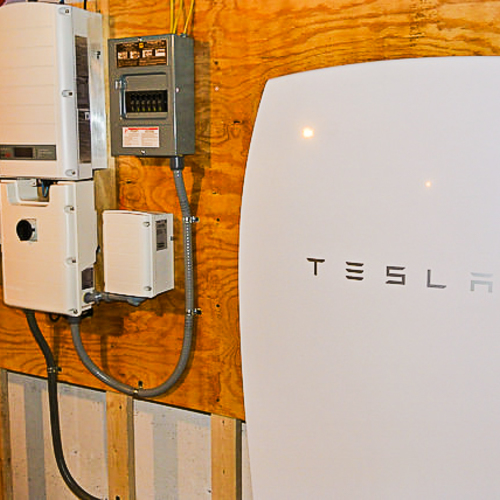Image Credit: Meaduva / CC BY-ND 2.0 / Flickr
Image Credit: Meaduva / CC BY-ND 2.0 / Flickr The Toon, an energy monitoring device offered by the Dutch utility Eneco, has been deployed in 300,000 homes.
After concluding that selling electricity as a commodity is no guarantee of business success, a Dutch utility has developed a variety of services to attract new customers and guarantee its survival in an era increasingly dependent on renewable energy.
What began as a bungled attempt to introduce energy monitors to a few Dutch households has since blossomed into a suite of new programs: charging electric vehicles, repairing solar panels, and tapping into energy stored on the home batteries of its solar customers. Along the way, Eneco has turned its energy monitor into a big success story.
The business approach, described in an article in The New York Times, is designed to give the company a more stable future as well as help transition its customers to a clean-energy future. Eneco executives adopted the plan after realizing that getting into price-cutting wars with its competitors for electricity and natural gas sales wasn’t going to take them very far.
“We said ‘we have to create an increasing customer loyalty by doing something different,’” said Hans Valk, chief executive of Eneco subsidiary Quby and formerly the leader of Eneco’s consumer business. “What we are trying to do is switch from selling a pure commodity to selling energy as a service.”
The start was slow
Eneco’s foray into new ventures was slow at first. The utility began by promising to distribute an energy monitor called the Toon (see Image #2, below) to several dozen homes. But the manufacturer didn’t supply enough of them, and some of those that were placed in customers’ homes didn’t work. Eneco went back to collect the Toons, but they found that some customers didn’t want to give them up. If the device itself had some problems, the idea that customers could monitor their own energy use was clearly a hit.
More than 300,000 Toons have since been installed, and Quby has agreed to supply them to utilities in Belgium and Spain.
Customers pay €3.50 (about $4.12) per month for the Toon. By monitoring energy use, customers should be able to reduce consumption by about 10%, according to Quby, but some customers have reported savings much greater than that.
Like the Nest and similar smart thermostats sold in the U.S., the Toon allows customers to change heat settings with a smartphone app. The device has displays to show how much electricity and natural gas are being used, and it can provide weather forecasts to help customers use power efficiently. The Toon also has helped Eneco retain customers: the number of those who jump ship for a competing provider of electricity has fallen by 60%.
As The Times reports, selling less electricity might seem like an odd goal for an electricity retailer, but the company says that it more than makes up for the lower sales with the growth of its service businesses. Plus, customers say they like the idea they are doing something positive for the environment by consuming less power, and the Toon helps them do that.
Launching other services
Eneco has several other ventures in the works. One of them, called Jedlix, is an app for charging electric vehicles that takes advantage of a surplus of low-cost wind power at night. Eneco says that the user decides the time at which he or she wants the vehicle to be fully charged, and the app “takes care of the rest.”
Eneco says partnerships with Tesla and Microsoft allowed it to create a flexible app just as interest in electric vehicles is on the rise.
There’s also Luminext, a monitoring system for outdoor lighting as well as solar panel repair. Its sizable investments in wind energy help attract customers who want to buy their electricity from clean sources, and it helped Eneco land a 10-year contract with Google for clean energy at a data storage center opened in the northern part of the country last year.
A program called “CrowdNett” is designed for Eneco customers who already own solar panels. The utility encourages these customers to install a battery, like the Tesla Powerwall, and then dips into the stored electricity to even out loads on the grid as needed. Participating customers get €450 a year (about $530) for their trouble. While still in its infancy, the program is appealing to customers who would like to see an end to the use of fossil fuels.
Some similarities here
Many U.S. utilities are using more conventional business models, and resisting a wider use of renewable energy by consumers, particularly rooftop solar, by seeking curbs on net-metering reimbursements. But in Vermont, Green Mountain Power has shown some of the same flexibility and willingness to experiment as Eneco, and utilities elsewhere are using a mix of efficiency programs and new business approaches.
In May, GMP began offering Tesla Powerwall 2 batteries and Tesla GridLogic software to customers, in part to lower demand on the grid at peak times. The utility said that it would be able to shave 10 megawatts off peak load, the same as taking 7,500 homes off the grid. By late June, the company said that it had requests for the battery from almost 1,000 customers.
GMP, a Certified B Corp, also began offering a Nest thermostat and an Aquanta water heater controller for 99 cents per month. The deal, like the Powerwall program, helps consumers save money, but it also gives the utility some ability to reduce demands on the grid by rescheduling when the water heaters will run. GMP also offered no-money-down deals on ductless minisplit heat pumps, and a $10,000 price break on a Nissan Leaf Flyer electric car.
In California, the Public Utilities Commission has approved pilot proposals to increase the use of electric vehicles, according to a post at Utility Dive. The $1.3 billion program to tap into the state’s investor-owned utilities would use a variety of means to boost electric vehicle use, including school and transit buses.
Con Edison in New York has used efficiency programs, neighborhood solar and other innovative measures to head off threatened power shortages and avoid spending $1.2 billion on a new electrical substation. The measures together cost $200 million.
New York energy chief Richard Kauffman said ConEd’s plan could be used elsewhere. “It’s not only an evolution of processes, thinking, and culture,” he said, “it’s also a gradual change in business models, evolving away from ‘programs’ to these activities being integral to the business itself.”
Weekly Newsletter
Get building science and energy efficiency advice, plus special offers, in your inbox.
















0 Comments
Log in or create an account to post a comment.
Sign up Log in